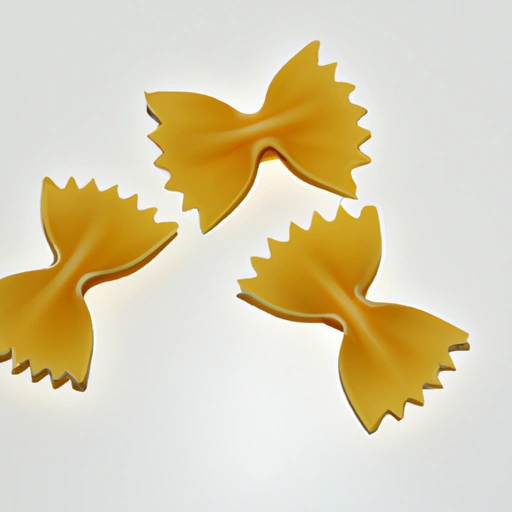Farfalle
Description

Farfalle, commonly known as bow-tie pasta due to its distinctive shape, is a type of Italian pasta that resembles a butterfly or a bow tie. It is made from a blend of durum wheat semolina and water, and sometimes eggs, which gives it a firm texture and a delicious taste that holds up well to a variety of sauces and cooking methods. Farfalle pasta comes in different sizes, from mini farfalline to larger farfalloni, and can be found both in its classic form or with ridges known as 'farfalle rigate.'
Common uses
Farfalle is a popular choice for cold pasta salads, baked pasta dishes, and as a companion to hearty sauces. Its unique shape allows it to trap and hold onto sauces, making it a favorite for dishes with chunky vegetable or meat additions. It is also a great option for adding a touch of elegance to a pasta dish, due to its distinctive and attractive appearance.
Nutritional value
Calories
Farfalle, like most pasta, is relatively high in carbohydrates and provides a good source of energy. A typical serving size of 2 ounces (56 grams) of dry farfalle pasta contains approximately 200 calories.
Protein
This serving size also contains around 7 grams of protein, essential for muscle repair and growth.
Fat
Farfalle is low in fat, with less than 1 gram per serving.
Carbohydrates
The carbohydrate content is about 42 grams per serving, mostly in the form of starch, which is a long-lasting energy source.
Vitamins
Depending on whether the farfalle is enriched, it may contain B-vitamins such as folate, which is important for cell function and tissue growth.
Minerals
Minerals such as iron may also be present in enriched farfalle pasta, aiding in oxygen transport throughout the body.
Health benefits
When consumed as part of a balanced diet, farfalle pasta can offer health benefits by providing a steady source of energy and essential nutrients. It can also be included in a high-fiber diet if made from whole-wheat flour, which can improve digestive health.
Potential risks
As with any carbohydrate-rich food, consuming farfalle in excessive amounts may lead to weight gain. Additionally, those with gluten intolerance or celiac disease should avoid traditional farfalle made from wheat. However, gluten-free options made from alternative flours are available.
Common recipes
Farfalle is used in a wide array of recipes, from 'Farfalle al Salmone' with smoked salmon and cream to 'Farfalle alla Primavera' with spring vegetables. It is also featured in soups, 'pasta al forno' (baked pasta), and tossed with pesto or tomato-based sauces.
Cooking methods
To cook farfalle, bring a large pot of salted water to a rolling boil. Add the farfalle and cook according to the package instructions, usually for about 8-12 minutes, until al dente. Drain and serve with your preferred sauce or ingredients.
Pairing with other ingredients
Farfalle pairs well with light olive oil or cream-based sauces, fresh vegetables, cheeses such as Parmesan or Pecorino, and proteins like chicken, shrimp, or salmon. It is also delightful in pasta salads, dressed with a zesty vinaigrette.
Summary
Farfalle pasta is a versatile and widely-enjoyed ingredient that can be used in a variety of culinary applications. Its unique shape and texture make it a favorite in both traditional Italian and contemporary global dishes. With its capacity to complement a range of flavors and sauces, farfalle is a delightful choice that can be enjoyed in many delicious ways.